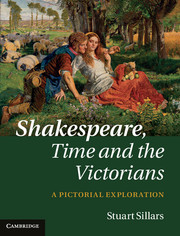Book contents
- Frontmatter
- Contents
- Colour Plates
- Illustrations
- Acknowledgments
- Chapter 1 History, Theatre and Shakespeare
- Chapter 2 Dress, Attribute and Image
- Chapter 3 Pre-Raphaelite Meridian
- Chapter 4 Charles Kean, Staging and Time
- Chapter 5 Memorialising Performance
- Chapter 6 Ars et Veritas
- Chapter 7 Fragmentation, Excision and Dispersal
- Chapter 8 Painting beyond Pre-Raphaelitism
- Chapter 9 Later Stagings and the Debate with Painting
- Chapter 10 Encounters and Memories
- Notes
- Select Bibliography
- Index
- Plate section 1-34
- Plate section 35-70
Chapter 1 - History, Theatre and Shakespeare
- Frontmatter
- Contents
- Colour Plates
- Illustrations
- Acknowledgments
- Chapter 1 History, Theatre and Shakespeare
- Chapter 2 Dress, Attribute and Image
- Chapter 3 Pre-Raphaelite Meridian
- Chapter 4 Charles Kean, Staging and Time
- Chapter 5 Memorialising Performance
- Chapter 6 Ars et Veritas
- Chapter 7 Fragmentation, Excision and Dispersal
- Chapter 8 Painting beyond Pre-Raphaelitism
- Chapter 9 Later Stagings and the Debate with Painting
- Chapter 10 Encounters and Memories
- Notes
- Select Bibliography
- Index
- Plate section 1-34
- Plate section 35-70
Summary
I
Victorian Shakespeare, with its complexes of authenticity, actuality and identity, is an intensely visual construction, reliant upon an ideology fiercely held yet rarely stated. To this, notions of time are central – time as made evident through history, time in the relation between past and present, time in organising the plays’ duration in performance and their rhythms while being read. The coming together of these forces in relation to the play is a microcosm, as well as a focussed concentration, of the much larger forces of time and the visual, two major determinants of Victorian worldviews, with which the plays interact in every dimension and at every level.
One point of entry into this maze of intersections and influences, that demonstrates a move from large social events and their supporting assumptions to a more precise field of enquiry into the plays in their Victorian configurations, is suggested by an image from the very centre of the age: The Opening of the Great Exhibition, by Henry Courtney Selous (Plate 1). The painting, and the event it both records and constructs, make forceful, ordered statements about the British Empire, projecting the Great Exhibition as a celebration of a defining moment in history. In this the painting typifies the concern to see the present through the past, to give it validation through its innate superiority while acknowledging its dependence on heroic precedent and tradition. The royal party at its centre present an affair of state as an intimate gathering, revealing innate values of dignified intimacy and emotional nurture, at the same time presenting the function of imperial splendour; they have about them the air of a family gathering or a moment from dramatic performance, immediate, personal, and shared by onlookers both in and before the canvas. Around them are balancing forms of the past, in the equestrian statues on either side, their presentation en grisaille as well as their partly concealed placing revealing their status as contributory rather than equal to the identities of the present. They are the figures, once vivid but now eclipsed, from whose earlier endeavours the fullness of the present has grown, and by which they are now eclipsed but still valued. In this the image reflects the idea that, as countless spectators noted at the time, this moment was history in the making: ‘The whole was a great national event; an epoch in history; a period to date from in the chronology of future annalists.’
- Type
- Chapter
- Information
- Shakespeare, Time and the VictoriansA Pictorial Exploration, pp. 1 - 35Publisher: Cambridge University PressPrint publication year: 2011

